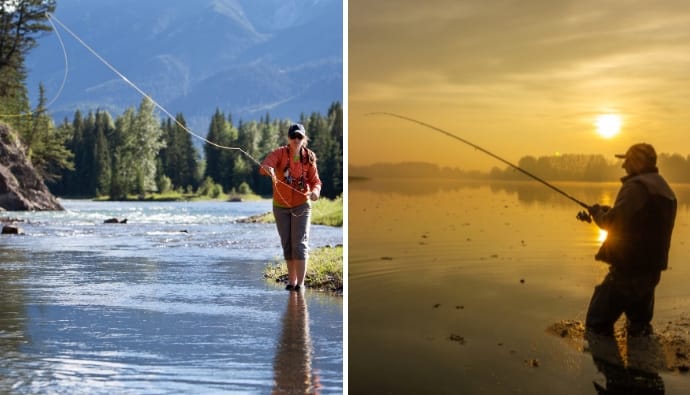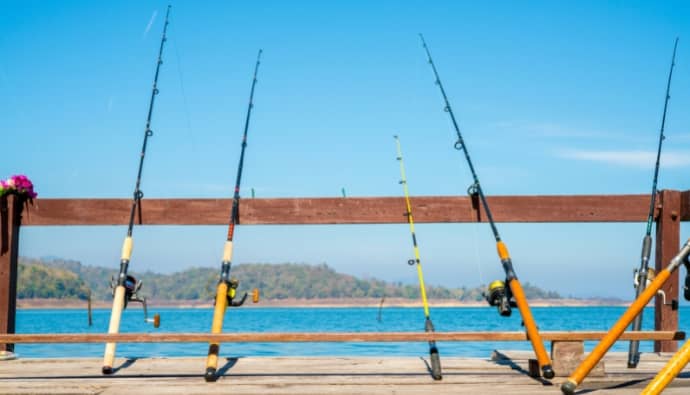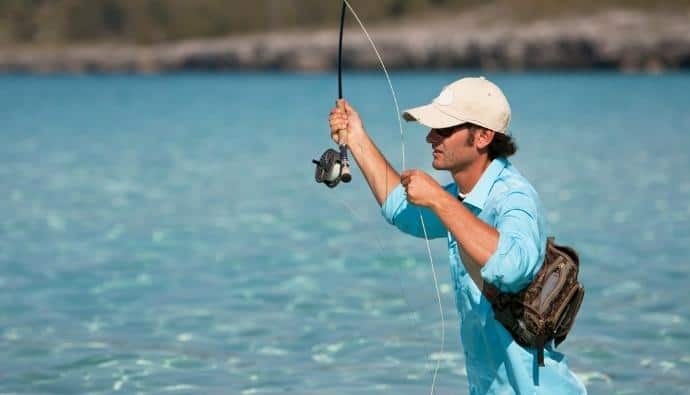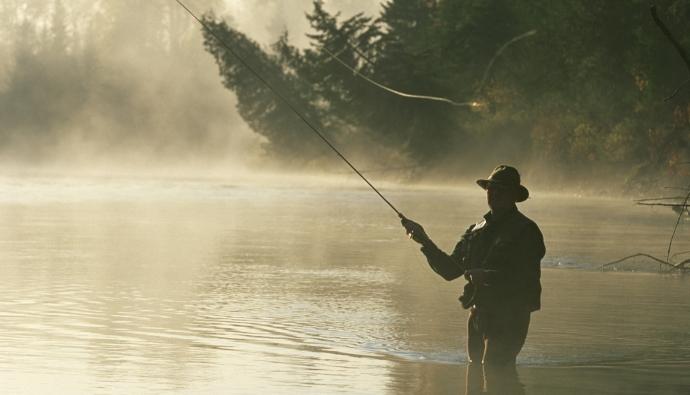Fly fishing is the most popular sport in North America. It’s an outdoor activity that you can do all year round, but it’s especially fun to go fly fishing in winter!
The weather heavily governs dry fly fishing on rivers at this time of year. Fish are likely to be sluggish, lying towards the bottom and not rising while still in the clutches of winter.
Wintertime is not the best time to try and catch some trout, but it doesn’t have anything to do with how cold or snowy outside you are.
Trout eat during winter; they’ll be more hungry than ever! This means that if there aren’t enough food sources available, things can get pretty bleak around the fly line.
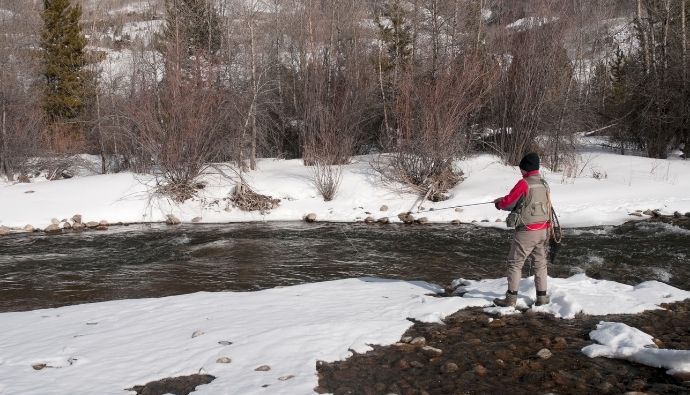
Here are some great spots for fly fishing:
Best Considerations in Winter Fly Fishing
The coldest months of the year are the time when you want to snuggle up, and chances are, you dream of escaping all the winter routines.
However, winter has a special way of making people think about the outdoors. One of them is to look forward to fly fishing.
It can be a challenge. The possibility of ice and the limited daylight hours may discourage some anglers. So, the following article will provide some helpful tips on how to fish in the winter season.
The Water
Water is important. It can be cold or warm, but it doesn’t matter. If you’re casting in the winter, you may ice the water over, and folks won’t be able to dive as deep as they can at other times.
Tailwaters are productive all through winter. The water released from dams is usually cold but not too cold. It is usually above 40 degrees, depending on the depth of the reservoir.
Trout can live in tailwater rivers, and they get a lot of food there, even in winter. In tailwaters, the best food for opportunistic trout is scuds, Mysis shrimp, stoneflies, caddisflies, and midges.
Hatches
Bugs can hatch in the winter. Bugs and midge hatch on cold trout streams. You might not see many big bugs, but it can be exciting during winter when you can easily catch midges for your fly fishing.
Adult midges are small. You can’t make a size 24, but you can make a 20. Griffith’s Gnat is a good strike indicator for midges.
Blue-winged Olives mayflies hatch on warmer days, even in the dead of winter. When it is cloudy, and above freezing, size 20 Blue-winged Olives are a good fly to use.
Low And Slow
During winter fishing, it is best to fish under slow water. Salmon wait for food underwater. If you are good at fishing with a rod and string, you can go fishing comfortably while waiting for your fishing gear to catch your bait.
A good fly would be the Zebra Midge tied with glass beads to imitate the air bubbles they use to float towards the water’s surface.
Then let it drift and swing out beneath you like a midge coming to the top of the water. You’ll be surprised at how many you can capture; anything may happen!
The Flies
If you want to catch fish in the winter, some of these bugs may be efficient in your fly box:
Griffith’s Gnats
Griffith’s Gnats are good for catching trout during the winter months. Cast them about 18 inches behind a larger fly, like an Adams Beetle.
This way, if you can’t tell which bug is attracting the fish, you’ll know when one rises near your fly and then quickly set the hook.
Prince Nymphs
Prince Nymphs are good to use in the winter. They look like stonefly nymphs or caddis nymphs. It is best used to tie with rubber legs, and they show up well in the winter.
Girdle Bug
The best fly is often a simple fly. This one is often the best for deep water. The rubber legs move in the current and get the trout’s attention.
Copper John
Copper John is a fly that is tied with wire of different colors. It sinks fast and can be made in many sizes. The big ones are good for imitating caddisflies, and the smaller ones are good for BWO.
Perdigon Nymphs
Perdigon nymphs are a type of fly. They sink like a rock and can be tied with bright colors. This makes them easier to see when you cast them underwater. They are good at catching, but they work best in pairs.
Woolly Bugger
Woolly Buggers are the best to use in winter. Fish may be hungry for protein, so that you can cast or drift streamers in the winter conditions.
Winter Fly Fishing Tips:
- Hunt during the hottest part of the day. Early in the morning, the water and weather are too cold, and the trout are sluggish. Warmer temperatures will stimulate its activity, resulting in more success than cold water.
- During the winter, trout have a much slower metabolism. They will stay low in the deep pockets, moving as little as possible to feed so that we can conserve as much energy as we can. As a result, reach the deep, slow-moving pockets of water and stay away from the short rifles.
- There are very few bug hatches in the winter, but there are usually midge hatches that you can use.
- Scale down your tippet. Opt for a lighter tippet in the winter, such as 6x, 5x, or 4x. Because it sinks faster, fluorocarbon tippet is ideal for nymphing.
- In the winter, a lighter tippet is more stealthy because the water is usually clearer in the winter, and the fish are more skittish, making your approaches stealthy. Dead Drift is the hack to catch one.
- Coldwater and freezing temperatures can cause ice to form in your guides. This can cause problems for anglers and guides and fly lines breaking or splitting. There are several ways to avoid this, but one quick tip is to dip and shake your rod in water to remove the ice in the surface film.
Tips to Protect Yourself from the Cold When Fly Fishing
A cold day means you have to work twice as hard to catch half as many fish. You may learn to fly fish in cold weather. However, it is also important to include proper gear and clothing before going to a cold river.
- Wear layers of clothing and wool socks.
- Wear gloves and put battery-powered hand warmers in your socks. You might not want to go outdoors.
- If you do go outside, wear a face-gaiter or something to protect yourself from the worst of the chill.
- Make sure you’re wearing a hat so your body heat doesn’t escape your head. Wear lots of layers so that if it is really cold, you have more protection. You also need water because you might get dehydrated being outside for too long in the cold weather.
In winter, it is hard to delve. You’ll be more successful in the cold if you remember these pointers. Bundle up, grab your fishing rod, and head out to a creek! Tight lines, avid angler!
Enjoy A Cold, Yet Fun Fishing Experience
It is perfectly doable if you want to go on winter fly fishing trips. You, as a fishing enthusiast, don’t need to be scared of the cold. Be smart and know your limits, and do some research first.
Then go fishing! Dead Drift will help you catch one. That will make you feel better than watching TV all day.



 Facebook
Facebook YouTube
YouTube
